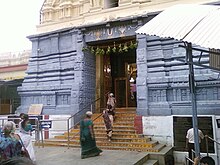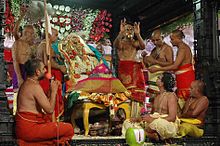Khammam is the city in Khammam district of the Indian state of Telangana. It is the fourth largest city in the state. It is the headquarters of the Khammam district and Khammam mandal also. It is located about 193 kilometres (120 mi) east of the state capital, Hyderabad, 61 kilometres (38 mi) from Suryapet, 120 kilometres (75 mi) from Warangal and also it is located about 121 kilometres (75 mi) North of the Andhra Pradesh state capital, Amaravathi. The river Munneru flows on the western side of the city. As of 2011 census of India, Khammam urban agglomeration has a population of 313,504. However, on 19 October 2012, the civic body of Khammam was upgraded to a municipal corporation. Post- upgradation to corporation, the population of Khammam was approximated to be 3,07,000.
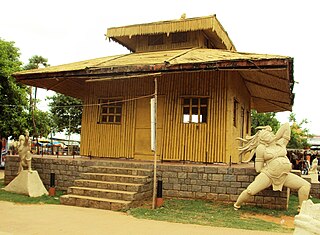
Parnasala is a village in the Dummugudem mandal in the newly formed Bhadradri Kothagudem district of Telangana, India. The village is accessible by road and boats and is situated 32 km from the temple town of Bhadrachalam.

Bhadrachalam is a census town in Bhadradri Kothagudem district in the Indian state of Telangana. It is an important Hindu pilgrimage town with the Bhadrachalam Temple of Lord Rama, situated on the banks of Godavari river. It is located 312 kilometres (194 mi) east of state capital, Hyderabad,115 kilometres (71 mi) from Khammam,178 kilometres (111 mi) from Suryapet,180 kilometres (112 mi) from Warangal,187 kilometres (116 mi) from Vijayawada,220 kilometres (137 mi) and 350 kilometres (217 mi) from Visakhapatnam.
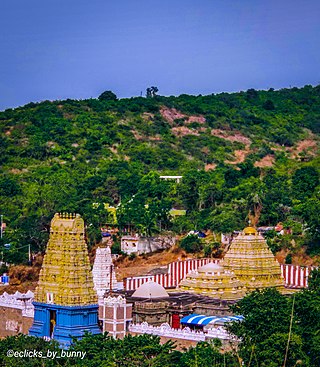
Sri Varaha Lakshmi Narasimha temple, Simhachalam, is a Hindu temple situated on the Simhachalam Hill Range,which is 300 metres above the sea level in Visakhapatnam, Andhra Pradesh, India. It is dedicated to Lord Vishnu, who is worshipped there as Varaha Narasimha. As per the temple's legend, Vishnu manifested in this form after saving his devotee Prahlada from a murder attempt by the latter's father Hiranyakashipu.Except on Akshaya Trutiya, the idol of Varaha Narasimha is covered with sandalwood paste throughout the year, which makes it resemble a linga. The temple was built in Kalingan architecture styles and stands unique in the historical region of Kalinga.The Present temple was built by Eastern Ganga king Narasingha Deva I in the 13th century and consecrated by his son Bhanudeva I in 1268 AD. The temple was built by Akthayi Senapathi, on the command of Narasingha Deva I.
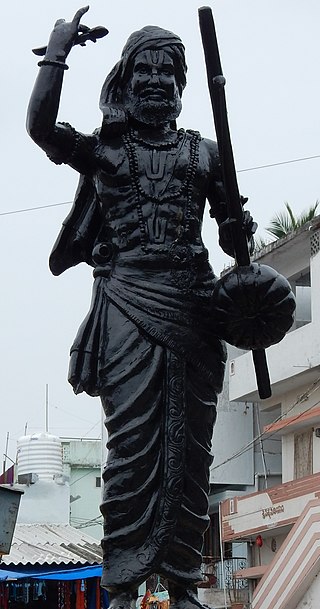
Kancharla Gopanna, popularly known as Bhakta Ramadasu or Bhadrachala Ramadasu, was a 17th-century devotee of the Hindu god Rama, a saint-poet and a composer of Carnatic music. He is a famous Vaggeyakara from the Telugu classical era. He was born in the village of Nelakondapalli in Khammam district, and orphaned as a teenager. He spent his later years in Bhadrachalam and 12 years in solitary confinement at the Golconda prison during the Qutb Shahi-rule. Different mythical stories about his life circulate in the Telugu tradition. He is renowned for constructing the famous Sita Ramachandraswamy Temple and pilgrimage center on the banks of river Godavari at Bhadrachalam. His devotional kirtana lyrics to Rama illustrate the classical Pallavi, Anupallavi and Charanam genre composed mostly in Telugu, some in Sanskrit and with occasional use of Tamil language. These are famous in South Indian classical music as Ramadaasu Keertanalu.

Sri Ramadasu is 2006 Indian Telugu-language biographical film, based on the life of musician saint Kancharla Gopanna. A reboot of V. Nagayya's 1964 film Ramadasu; the film is written and directed by K. Raghavendra Rao. Produced by Konda Krishnam Raju the film starred Akkineni Nageswara Rao, Akkineni Nagarjuna, Suman, Sneha and music was composed by M. M. Keeravani. Cinematography and editing were handled by S. Gopal Reddy and Sreekar Prasad respectively. Upon release, the film got positive reviews.
Sri Venkateshwara Swami Temple is a landmark vaishnavite temple situated in the hill town of Tirumala at Tirupati in Chittoor district of Andhra Pradesh, India. The Temple is dedicated to Lord Venkateswara, an incarnation of Vishnu, who is believed to be appeared here to save mankind from the trials and troubles of Kali Yuga.
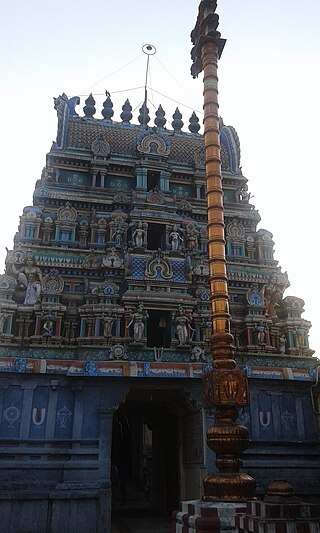
The Devaadi Raja Perumal temple in Therazhundur, a village in Mayiladuthurai district of the South Indian state of Tamil Nadu, is dedicated to the Hindu god Vishnu. Constructed in the Dravidian style of architecture, the temple is glorified in the Naalayira Divya Prabandham, the early medieval Tamil canon of the Alvar saints from the 6th–9th centuries CE. It is one of the 108 Divya Desams dedicated to Vishnu, who is worshipped as Amaruviappan, and his consort Lakshmi as Sengamalavalli Thayar. The original structure of the temple was built by the Karikala Chola during the 1st century CE, with later additions from the Cholas during the 11th century.

Nelakondapally, also referred to as Nelakondapalli or Nela Kondapalli, is a town and headquarters of a mandal in Khammam district, Telangana, India. It is also an archaeological site important to early Buddhism and Hinduism, where excavations have discovered a major stupa site near an ancient manmade lake, another site where Buddhist and Hindu artwork were carved in pre-3rd century India, both sites also yielding hundreds of ancient rare coins with Shaiva and Vaishnava inscriptions from the dynasties of Andhra Ikshvakus and Vishnukundinas. Nelakondapally is also the birthplace of Bhakta Ramadasu.

Tirupavalavannam or Pavalavanam temple located in Kanchipuram in the South Indian state of Tamil Nadu, is dedicated to the Hindu god Vishnu. Constructed in the Dravidian style of architecture, the temple is glorified in the Nalayira Divya Prabandham, the early medieval Tamil canon of the Alvar saints from the 6th–9th centuries CE. It is one of the 108 Divya Desams dedicated to Vishnu, who is worshipped as Pavalavannar Perumal and his consort Lakshmi as Pavalavalli.

The Thiruneermalai temple complex consists of two temples, the Ranganatha Temple and the Thiruneermalai Neervanna Perumal Temple. Both are Hindu temples in Thiruneermalai, a suburb of Chennai, Tamil Nadu, India.
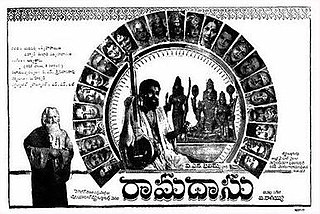
Ramadasu is a 1964 Indian Telugu-language biographical film, based on the life of Kancharla Gopanna, produced and directed by V. Nagayya. It stars Nagayya, with N. T. Rama Rao, Akkineni Nageswara Rao, Sivaji Ganesan and Anjali Devi in special appearances, with music composed by Ashwathama. The blockbuster film has garnered the National Film Award for Best Feature Film in Telugu, and has garnered several state awards.
The Telangana State Tourism Development Corporation is a state government agency which promotes tourism in Telangana, a state in the Southern region of India. The retired Director General of Police Pervaram Ramulu is the appointed First chairman of Telangana State Tourism. Tourist attractions in Telangana include historical places, monuments, forts, water falls, forests and temples.

The Culture of Telangana in India has a cultural history of about 5,000 years. The region emerged as the foremost centre of culture in Indian subcontinent during the rule of Kakatiyas, the Qutb Shahis and Asaf Jahi dynasties—. The rulers patronage and interest for culinary, arts and culture transformed Telangana into a multi-cultural region where two different cultures coexist together, thus making Telangana the representative of the Deccan Plateau and its heritage with Warangal and Hyderabad being its epicenter. Hyderabadi cuisine and Kakatiya architecture both from Telangana, are on the list of UNESCO creative city of gastronomy and UNESCO World Heritage Site. The regions major cultural events celebrated are "Kakatiya Festival" and Deccan Festival along with religious festivals Bonalu, Bathukamma, Dasara, Ugadi, Sankranthi, Milad un Nabi and Ramadan.
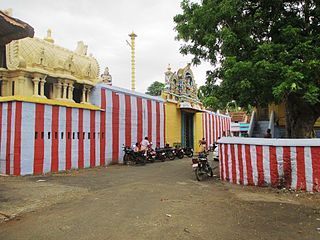
The Thiruvazhmarban Temple, also known as Sri Kuralappa Perumal Temple in Thiruppathisaram, a village in Kanyakumari district in the South Indian state of Tamil Nadu, is dedicated to the Hindu god Vishnu. Thiruvazhmarban Temple is located about 5 km far, north-easterly to Nagercoil, 20 km far, north-westerly to Kanyakumari and 45 km south-west of Nanguneri Divya Desam. Constructed in the Dravidian style of architecture, the temple is glorified in the Nalayira Divya Prabandham, the early medieval Tamil canon of the Alvar saints from the 6th–9th centuries CE. It is one of the 108 Divya Desams of malayala nadu divyadesham dedicated to Vishnu, who is worshipped as Thiruvazhmarban and his consort Lakshmi as Kamalavalli in kerala tantric traditions. The oldest inscription in the temple is from 1139 CE indicating gifts to the temple. A granite wall surrounds the temple, enclosing all its shrines. The temple tank is located opposite to the temple, outside the main entrance.

Bhadradri Kothagudem district is a district in the east of the Indian state of Telangana. Kothagudem is the district headquarters. It is the largest district in Telangana, with an area of 7483 km2. It borders the districts Khammam, Mahabubabad, Mulugu, Eluru and East Godavari, and shares a boundary with the bordering state Chhattisgarh. The district comprises 24 mandals and 2 revenue divisions, Kothagudem and Bhadrachalam.
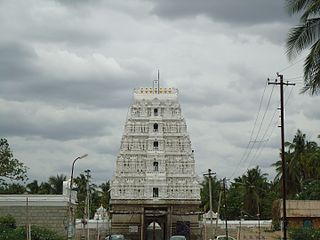
Sri Venugopalaswamy Temple is a Hindu-Vaishnavite temple situated at Karvetinagaram in, Chittoor District of Andhra Pradesh state, India. The Temple is dedicated to Krishna, considered by believers to be the ninth incarnation of Vishnu's Dasavatharam, who is referred to as Venugopala. It is situated at a distance of 58 km from Tirupati and 12 km from Puttur.

Sita Rama Lift Irrigation Project is an under-construction barrage across Godavari River with run-of-river hydroelectric power project at Dummugudem village, Bhadradri Kothagudem district in Telangana. The project is proposed at about 200 meters downstream of the existing Dummugudem anicut built about 150 years ago.
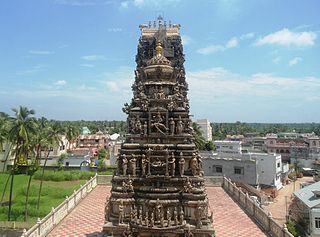
Kodandarama Temple is a Hindu temple located in Gollala Mamidada in Kakinada district of Andhra Pradesh, India. The temple is dedicated to Rama, the seventh incarnation of Vishnu. It was built on the banks of Tulyabhaga (Antharvahini), a tributary of Godavari.
The Yogananda Lakshmi Narasimha Swamy Temple, also known as Mattapalli Narasimha Temple, is a Hindu temple dedicated to Narasimha, the half-man half-lion avatar of Vishnu, and his consort Lakshmi. It is located in Mattampally, a village in the Mattampally mandal of Suryapet district in the Indian state of Telangana. One of the Pancha Narasimha Kshetras, the temple is located on the banks of the Krishna River, and was built in the 11th century by Anumala Machi Reddy, the king of Thangedu region after the deity appeared in his dream and instructed him to do so. The main shrine houses a swayambhu (self-manifested) idol of Narasimha as Yogananda Lakshmi Narasimha, and was worshipped by sage Bharadvaja and other seers for hundreds of years before the temple was constructed. Lakshmi is worshipped here as Rajalakshmi Thayar and Chenchu Lakshmi Thayar.





